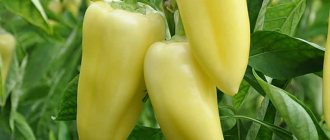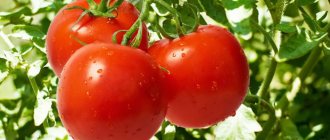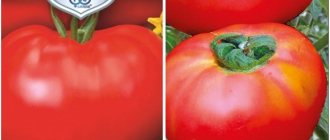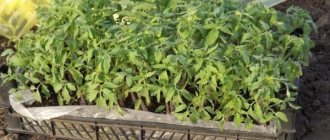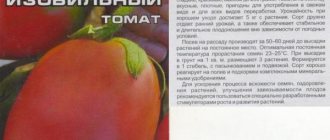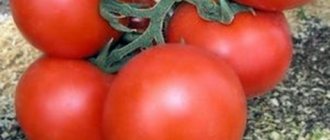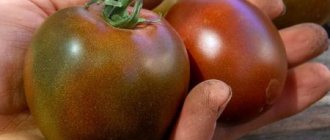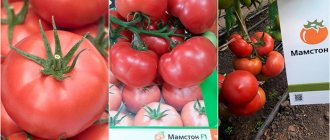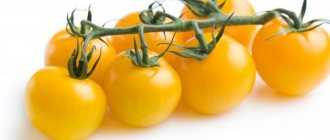Description of plants
Snowfall F1 is a first generation hybrid bred by Russian breeders. Most of the seeds on the market are produced under the popular Sedek brand. The tomato is mid-season, 100-110 days pass from the emergence of seedlings to the start of harvesting. The bushes are tall, indeterminate, suitable for growing in glass greenhouses or unheated summer greenhouses. In shelter, plants reach two meters in length and require pinching. To stimulate the formation of ovaries, bushes are formed into 1 or 2 stems, removing side shoots and deformed flowers. In regions with a mild climate, plants can be planted directly in the ground, in which case they grow less spreading. The hybrid is suitable for year-round cultivation in polycarbonate greenhouses equipped with heating, lighting and automatic watering systems.
The bushes grow abundant green mass, medium-sized leaves, dark green, heavily cut. The stems are strong and not prone to breaking. The fruits are collected in small clusters of 6-8 pieces, the ripening is extended, which allows you to collect ripe tomatoes throughout the season. The productivity is high; up to 4 kg of selected tomatoes are harvested from 1 bush, picking them individually or cutting them off in whole clusters. The collected fruits are stored well; if necessary, they can ripen at room temperature. Can be transported over long distances.
The hybrid is resistant to typical nightshade diseases: cladosporiosis, verticillium, tobacco mosaic, viral leaf spot, gray or blossom end rot. Early ripening protects fruits from late blight. Small or ugly specimens are practically never found; each tomato fully corresponds to the declared characteristics.
The fruits are medium-sized, weighing 100-130 g; on the lower branches they grow larger. The shape is flat-rounded, with pronounced ribbing at the stalk. The skin is smooth, glossy, not too hard, but well protects the pulp from cracking. As tomatoes ripen, they change color from apple green to dark red. The coloring is uniform, without spots or stripes.
Tomatoes have few seeds, a small number of chambers and a high dry matter content. The pulp is moderately dense, juicy, sugary at the break. The taste is rich, sweet with subtle fruity notes, the aroma is delicate and persistent. Excellent consumer qualities make ripe tomatoes suitable for dietary or baby food.
Advantages and disadvantages
The Snowfall hybrid has many advantages that make tomatoes especially tempting for amateur gardeners and farmers:
- high productivity;
- ease of care;
- excellent taste of the fruit;
- spectacular appearance of ripe tomatoes;
- tomatoes are suitable for canning and fresh consumption;
- good keeping quality;
- can handle transportation without any problems;
- suitable for industrial cultivation or private farmsteads;
- resistance to major diseases and viruses.
Despite the extensive list of advantages, tomatoes also have disadvantages. Plants are very sensitive to temperature fluctuations and do not like frost, sweltering heat and drought. They are demanding on the composition of the soil; in heavy clay soil, the yield is greatly reduced.
Tall bushes require shaping and fastening to strong supports: wooden trellises or stakes. As they ripen, branches with heavy fruits also need to be tied up. Growing tomatoes require constant pinching. If the side shoots are not removed, the plantings turn into an impenetrable thicket, the number of ovaries decreases, and the tomatoes themselves become smaller.
Another disadvantage is the inability to collect seeds for subsequent cultivation. They ripen, but do not carry all the advantages of the mother plant. This drawback is typical for all hybrids and does not cause confusion among experienced gardeners.
Subtleties of cultivation
Snowfall tomatoes are grown in seedlings. Depending on the region, seeds are sown at the end of February or the first ten days of March. Before planting, they are treated with a growth stimulator; for greater safety, treatment with an aqueous solution of potassium permanganate or hydrogen peroxide is possible. Seeds from Sedek, which have undergone pre-sale preparation, do not require special disinfection (the relevant information is available on each package).
The soil should be light and nutritious, with an admixture of sand and old humus. To stimulate the growth of tomatoes, wood ash and superphosphate in granules are added to the soil. You can sow seeds in common containers, but it is much more convenient to use individual peat pots. Tomatoes planted in them do not need picking, grow stronger, do not get sick and begin to grow faster after moving to the greenhouse.
After sowing, the seeds are sprinkled with a thin layer of soil and generously sprayed with warm, settled water. The mini-plantation should be covered with glass or film, and then placed in a warm place until germination. When the first leaves unfold, the containers are moved to bright light. Plantings need to be protected from drafts; it is recommended to water with warm water and spray the air around the plants.
Agricultural technology tomato Snowfall F1
The time for planting seeds depends on the climatic characteristics of the region. The best time to start germinating tomatoes is the spring months from March to April.
For disinfection, seeds are treated with a solution of potassium permanganate or hydrogen peroxide. Experienced gardeners recommend soaking the seeds in a growth stimulant to speed up the appearance of sprouts.
To plant seeds, you must first prepare:
- purchase seedling containers;
- Buy ready-made soil in a specialized store or make it yourself from humus and soil in equal parts (add a little extra sand to make the soil structure airy and loose).
Growing seedlings
Growing tomato seedlings Snowfall F1 begins with sowing seeds. A layer of gravel is poured into the bottom of the container and soil is poured on top. Make furrows 1-2 cm deep and sow 1-2 seeds. The seeds are watered with warm water and covered with polyethylene to create a greenhouse effect. In a humid and warm environment, seedlings appear faster.
After a week, sprouts appear with a light green tender stem and the first two leaves.
With the appearance of the 2nd - 3rd leaf, you can transplant the young plants into separate pots.
When transplanting plants from a common container, it is important to monitor the soil and sunlight. Young seedlings are capable of stretching out behind a portion of rays, so periodically it is necessary to turn the pots of tomatoes so that the trunk of the plant is straight and does not bend in one direction or the other
Landing rules
Before planting, young seedlings begin to harden off. This process takes up to 2 weeks. First, the pots with the plant are placed on the balcony or street for a few minutes, then the time is increased to several hours. Every day the plants stay outside should increase. This is necessary for adaptation and rapid rooting of tomato bushes in the ground.
For the correct formation of the root system and uniform distribution of sunlight, plants need to be planted at a density of more than 3 - 4 bushes per 1 square meter. m. It is necessary to install supports next to the bush, because in a couple of weeks rapid growth will begin: you will have to tie up the trunk and branches.
Watering and fertilizing
The tomato belongs to the nightshade family, which requires sufficient water for normal development. An important feature: young plants need water and fertilizing in larger quantities than adults. As they grow, tomato bushes are watered less and less, reducing watering to once a week. Excessive moisture can lead to cracking of the fruit or rotting of the entire bush.
The Snowfall F1 tomato is unique in that it tolerates long periods of time without watering.
As a top dressing, tomatoes accept complex mineral supplements well. Organic mulch in the form of hay, sawdust or straw can become a source of additional plant nutrition.
Pinching and tying
The correct tomato bush is:
- root system;
- main stem;
- branches with leaves.
Shoots form on the main stem, which can take away nutritional properties and strength. In order for the plant to direct all its strength into one trunk, young shoots must be pinched in a timely manner.
If a tomato bush consists of 2 or more stems, then the harvest becomes small or absent altogether.
Formation
A large indeterminate bush of the Snowfall F1 variety requires formation and timely tying up.
The stem holds branches with powerful leaves and clusters of tomatoes. It needs help, so tying it up will protect the plant from fractures.
This is especially true during the first snow. The tied branches will withstand even such a load.
Protection from diseases and pests
The most common problem that all summer residents encounter is late blight. Hybrid Snowfall F1 is resistant to this disease and to all other diseases typical of nightshades.
For Snowfall tomatoes, it is enough to carry out preventive work:
- remove wilted leaves and weeds;
- strengthen plants by fertilizing with mineral fertilizers;
- use folk methods in the form of spraying from decoctions of onion peels or bread tincture.
Life in a greenhouse: how adult tomatoes develop
Plants are planted in shelter in the first ten days of May. The end of the month is more suitable for transplanting into the ground, but much depends on the climatic conditions of a particular region. The soil should warm up completely, but not dry out. If transplanting into beds is to be done, the soil is thoroughly loosened and covered with plastic film, which retains heat and moisture.
In the greenhouse, the top layer of soil is renewed annually. Garden soil should be mixed with humus, adding a small portion of washed river sand. Tomatoes are planted at a distance of 40-50 cm from each other. Add 1 tbsp to each well. l. superphosphate or wood ash.
Immediately after transplantation, the seedlings are tied to stakes, metal rods or trellises. The supports must be strong and high; the plants develop very quickly. For better development, tomatoes are formed into 1-2 stems, promptly removing the lateral shoots. After 3 weeks, it is necessary to water the young bushes with liquid complex fertilizer with a predominance of potassium and phosphorus. You should not overuse fertilizing with nitrogen (such as urea). They promote the growth of green mass and inhibit the formation of ovaries.
Tomatoes do not like heavy watering, preferring moderate soil moisture 2 times a week. In dry summers, the intensity of irrigation can be increased. Sprinkling is not recommended; bushes develop better when watered at the root. After moistening the soil, the greenhouse is ventilated, this prevents the appearance of gray rot and blackleg. In between, the soil needs to be loosened, carefully breaking the crust that blocks air access to the roots.
Snowfall responds well to foliar feeding. The bushes are sprayed with diluted superphosphate 1-2 times per season. Mulching the soil with peat, sawdust or sunflower seed peels will help protect plantings from pests. If aphids are infested, the bushes are washed with warm soapy water; an aqueous solution of ammonia helps against naked slugs.
General characteristics
The originator of the variety is the Pridnestrovian Research Institute of Agriculture.
The variety was bred for cultivation both in greenhouses and in open ground. The second option is suitable for regions with warm climates. The hybrid produces a high yield; its bushes reach a height of two meters. Tomato bushes grow moderately spreading and form a large amount of greenery. The stem is green, thick, the edges are barely noticeable. The leaf is simple, five-lobed, small in size.
The flowers of the plant are small, up to 12 mm in diameter, the inflorescence is a raceme that collects up to 10 flowers. Many ovaries are formed, almost every flower bears fruit.
Fruiting time is 4-5 months from the moment the seeds are planted. The time to obtain tomatoes will depend on when to sow the tomato seedlings during cultivation. To speed up the ripening of fruits, you should increase the amount of heat and light.
Greenhouse neighbors
Snowfall is a mid-season variety, so plants with a different growing season can be planted in the same shelter with it. Ultra-early hybrids are suitable: tomato Pink Lady F1, Ivanhoe, Indigo. They begin to bear fruit earlier than Snowfall, and the tomatoes have a rich, pleasant taste. It is better to purchase plant seeds from trusted sellers; the Sedek company, which specializes in new products, has proven itself to be excellent. The company annually offers interesting hybrids with fruits of different sizes, colors and shapes. Lovers of gourmet vegetables will enjoy late-ripening classic varieties such as Black Baron, Chernomor, De Barao, and Bull's Heart. These tomato varieties ripen towards the end of summer and are a great complement to early hybrids.
The Irishka tomato, bred by Russian breeders, deserves special attention. This particularly early hybrid begins to bear fruit 90-95 days after germination, the tomatoes ripen with beautiful long trusses. Another promising neighbor is the Lyubov tomato, which belongs to a large and popular group of mid-early hybrids. The plant is determinate, miniature bushes tolerate lack of light well and will feel quite comfortable in the same greenhouse with tall Snowfall.
Planting seeds
Features of planting the Snowfall tomato are not much different from other varieties. The only differences can be in the timing of cultivation. Gardeners are faced with the question of when to sow tomatoes for seedlings when grown in a greenhouse or in open ground. In the first case, seeds are sown for seedlings at the end of February, in the second - in mid-March.
The soil for seedlings is nutritious, with neutral acidity. You can mix garden soil, humus and sand in equal proportions. They also add a little ash or superphosphate. Instead of humus, peat is also suitable, then take one part of it, and two parts of earth and sand.
The soil must be disinfected; before planting, the seeds are disinfected in a weak solution of potassium permanganate or hydrogen peroxide. The seeds are sown in plastic containers or in individual peat cups. In the latter case, the seedlings will not need to be picked and replanted. Plant the material in small holes 1-2 cm deep, two seeds each.
If containers are used, the distance between the furrows is 5-6 cm. In this case, the seeds are planted one at a time, every 2-3 cm. Next, the seeds are sprinkled with soil, the soil is moistened and covered with film. The containers are placed in a warm, dark place until seedlings emerge.
As soon as the first shoots hatch, the film is removed, the seedlings are placed in the sun, and the temperature is lowered by 2-3 degrees.
Planting
Features of care
What to pay attention to when growing?
When cultivating the Snowfall tomato, you should pay close attention to the formation of bushes. This process begins immediately after transplantation and continues until fruiting. Bushes should be single- or double-stemmed
At the same time, it is important to constantly remove stepchildren. The bushes grow quite tall, so they are tied to trellises
The use of mulch will greatly facilitate many stages of tomato cultivation, and this is also worth considering in advance. Sawdust or peat are suitable for tomatoes. Such mulch will prevent the proliferation of pests and simplify the process of caring for plants, eliminating constant loosening and removal of weeds.
If a problem such as fungal infection of tomatoes occurs, copper sulfate or Bordeaux mixture will help. The parts of the plant affected by the disease are completely removed. To control pests, use insecticides or a decoction of onion peels and celandine.
Such compositions can be used for spraying and also for watering beds where bushes grow.
Who does he get along with?
Snowfall is a mid-season variety, so tomatoes with other growing seasons can be planted in the same greenhouse with it. For example, ultra-early varieties: Irishka, Ivanhoe, Indigo. Their fruits will appear earlier, but they differ in no less rich taste. Among the late-ripening varieties, you can consider Chernomor, Black Baron, and Bull's Heart.
Gardeners' opinions
Gardeners' opinions
Amateur gardeners leave positive reviews about the hybrid. They note good productivity and responsiveness to care. Snowfall is suitable for growing in any shelter, from film greenhouses to full-fledged heated greenhouses. Grown bushes get along without problems with other varieties. The plants are unpretentious, they rarely get sick and are almost not affected by insect pests. The hybrid is suitable for beginning farmers and ordinary gardeners. Snowfall is not bad for year-round cultivation. To enhance fruiting, good lighting, moderate watering and abundant fertilizer are important.
Gardeners clarify that only high-quality seed material guarantees good results. It is better to purchase seeds from trusted retail outlets; it is advisable that the bags are labeled. Tomatoes from Sedek have a good reputation. In addition to Snowfall, she offers such popular hybrids as Cornabel F1, Lyubov F1, Keraso F1, Rose. All tomatoes fully comply with the declared characteristics, the seeds have good germination. Sedek products are especially popular with gardeners who prefer interesting new products.
Hybrid Snowfall is a real find for amateur gardeners. Having planted a few bushes for testing, most owners of household plots expand the plantations. Tomatoes are unpretentious; they respond to proper care with an excellent harvest.
